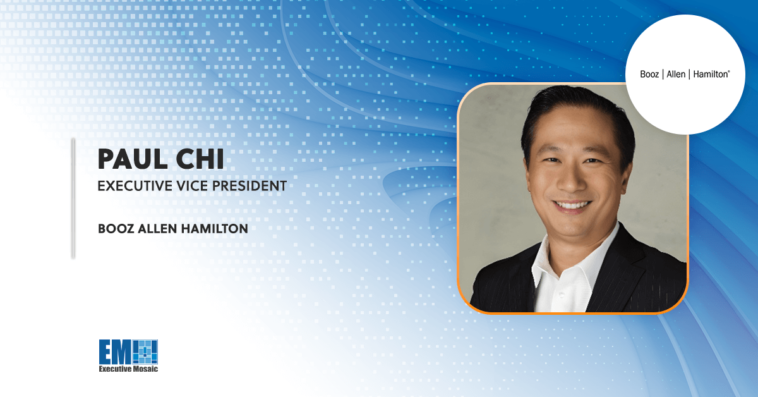Paul Chi is a three-decade Booz Allen Hamilton executive who enjoys looking at things differently, whether adding AI to signal processing, exploring robotics, or capturing photos in his personal time. His work for Booz Allen, which began immediately following his graduation from the University of Michigan with a bachelor’s in electrical engineering, has included deep interface with the Department of Defense and commercial clients developing and delivering services in signals intelligence analysis, information security, data analytics and more.
Currently, Paul is an executive vice president with the company overseeing its intelligence business. His cohort’s principal work is in data science, information technology, cybersecurity and engineering, among other focus areas.
This month, Paul sat down with ExecutiveBiz to mull over the many impacts of the conflict in Ukraine on how and what technology the U.S. government implements, with a specific focus on classified environments and unmanned aerial vehicles. He also mused about Internet of Things tech and the proliferation of sensors.
Classification can sometimes be a barrier for the intelligence community in working with industry or even other government agencies. How can we change that narrative and enable more robust public-private partnerships without jeopardizing security?
Classification can be a barrier, simply due to how long clearances take to secure. This is especially an issue for recent graduates who face years-long delays before even being introduced to the intelligence community, let alone becoming strong contributors to our national security. This cycle has historically kept industry and other government agencies from benefitting from the latest talent and knowledge. But more recently, the narrative has changed.
In combination with the lesson the pandemic taught us — that it is possible to be productive in unclassified environments — an attitude shift has pushed the government to allow more flexibility in contract restrictions. We are seeing more exploration into the venture world, doing work across classification levels and other solutions that have proven to be effective without jeopardizing the necessary level of security.
More specifically, there has been a lot of momentum in development efforts that originate in less classified environments that get promoted to more classified domains as the effort matures. We have been able to use unclassified technology that has been upgraded into the final mission area, while still preserving security. The more these successes are visible and advertised, the more the IC can feel comfortable taking advantage of them. Take Ukraine, for example, which has been fighting in the most open conflict yet. They have very publicly shown the success they have had using commercial products, communications, maps and imagery, which further proves the value of commercial capabilities in the warfighting and intel domains.
What do you think is the number one lesson we can learn from the Russian invasion of Ukraine? What information have we gathered that will help the U.S. military to better prepare for and respond to future conflicts?
The most prominent change in tactics we have seen in this war is the use of unmanned aerial vehicles or UAVs. We have observed how strategic UAVs are as tools in conflict and how they can be leveraged. They can be used to collect surveillance, fly to other countries to bomb tanks and so much more. The use of UAVs has introduced an entirely new aspect to warfighting.
There has also been a lot to gauge from open source media usage. Onboarding the media in the right way in both home country and away has some political benefit, especially as it comes to what the active narratives are and what they should be. This change marks a new era in what was traditionally a closed source, closed environment where managing the media was much more attainable.
What emerging technologies do you anticipate will have the greatest impact on our standing in the great power competition in the next few years? Where are you seeing opportunities for accelerated, meaningful tech growth for the U.S.?
On one hand, you have a lot of focus on emerging technology for the physical long-range missions: how can you fire from far away, how can you get strategic advantage from space, how can you affect national-level systems? On the other hand, there is a focus on how to use technology for intelligence — and in a world where nearly everything is now a sensor, there is a lot of opportunity to collect reconnaissance.
There are new ways of interaction where tech firms are enabled by nation-states: something as simple as accessing Google Maps on someone’s phone can give innumerable insights throughout their day and help characterize people of interest. Anything can be a collection platform. This is a dual issue, as it offers as much opportunity for the U.S. as it does for our adversaries. That means to counter these threats — apps, 5G/4G, any technologies in cellular — we need to fully realize the scope of the growth of attack vectors and be agile and capable on more technological fronts.
How is your organization adapting and responding to the proliferation of sensors and the rapid expansion of the Internet of Things?
From a cyber defense standpoint, we need to be more cautious than ever about what we deploy on our networks, because growth in IoT has created immense opportunity for intel collection, which is both an opportunity and a threat.
To our advantage, it has opened up avenues that help us get creative and bypass custom development. Consider Bluetooth-enabled earphones, which include a speaker, a mic and a wireless connection. These are exactly the features that our clients in the IC need for their missions. If you think of it that way, IoT has broadened our collection capabilities.
As a firm we have used this creatively to turn the technology sideways and determine how our clients can strategically leverage IoT to get the information they need. We have a long history in understanding mission needs, and as a technology integrator, we have been in a unique position to combine that intimate understanding with the latest innovations we are seeing in the venture world and the engineering we do on our side. We have really been able to take a long view of what is the latest in technology and how our clients can use it to their advantage and IoT has been a huge part of those conversations.




